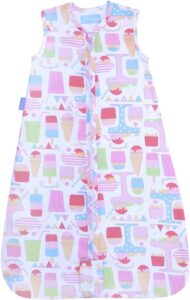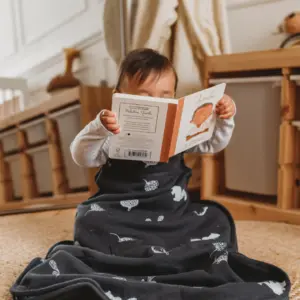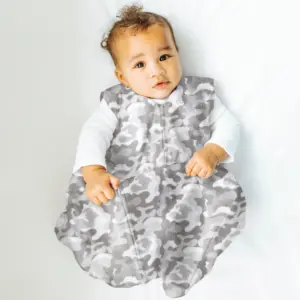Baby Sleeping Bag: Safety and Comfort Combined
Parenthood is an adventurous journey filled with choices, and when it comes to ensuring comfort for your tiny tot, a Baby Sleeping Bag is a fantastic option. Let’s delve deep into its world and understand its charm.
Introduction to Baby Sleeping Bags
Stepping into the world of parenting often feels like navigating through a maze, especially with the myriad of baby products flooding the market. Enter the Baby Sleeping Bag – a product designed not as a mere accessory but as an essential. Unlike traditional blankets or swaddles, these bags offer a cocoon-like shelter for your little one, ensuring they remain covered and snug throughout their slumber. They’ve become an essential tool in modern-day parenting arsenals due to their combination of practicality and peace of mind they offer.
Benefits of a Baby Sleeping Bag
Sleeping bags for babies have surged in popularity in recent years. While they appear simple, their benefits are multi-faceted. Not only do they provide a comfortable sleep environment, but they also address multiple concerns parents often grapple with, like safety and temperature regulation. Moreover, as a solution to the restless sleepers who enjoy kicking off their covers, these bags ensure your baby remains cozy, making nighttime disruptions less frequent.
Safety First
Perhaps the most significant selling point of a Baby Sleeping Bag is the safety aspect. Traditional blankets, although fluffy and warm, pose risks. Babies tend to move around in their sleep, and there’s always the concern of a blanket covering their face, which can lead to potential breathing obstructions. With sleeping bags, such fears are considerably minimized. The design ensures that there are no loose fabrics around the baby’s face, thereby significantly reducing risks associated with loose bedding. Many pediatricians and sleep experts have even highlighted their potential role in reducing the chances of Sudden Infant Death Syndrome (SIDS).
Consistent Temperature
One primary concern for every parent is ensuring their baby sleeps at a consistent temperature, not too warm or too cold. This becomes a challenge with traditional blankets which can be kicked off. With Baby Sleeping Bags, your baby remains enveloped in a consistent warmth. The design caters to maintaining a uniform temperature, ensuring that your baby doesn’t wake up chilly in the early hours. It’s a game-changer, especially for parents living in places with colder climates or varying temperatures.
Mobility and Comfort
Babies are explorers by nature, even in their sleep. They love to wiggle, stretch, and occasionally roll. A Baby Sleeping Bag, contrary to initial impressions, doesn’t inhibit these movements. Instead, it provides ample space for babies to move their legs freely. The snug fit ensures they’re comfortable but not restricted. It strikes the perfect balance between giving them the freedom to move while ensuring they feel enveloped and secure, much like how they felt in the womb.
What to Look for When Buying
Entering a baby store or even searching online for baby sleeping bags can be overwhelming. The sheer variety and options available can stump even the most informed. However, by focusing on a few essential aspects, you can make the best choice for your little one, ensuring their comfort and your peace of mind.
Material and Breathability of Baby Sleeping Bag
First and foremost is the material. Babies have sensitive skin, which can easily get irritated. Opting for natural fibers like cotton or bamboo can make a world of difference. These materials are not only soft and gentle on your baby’s skin but are also highly breathable. Breathability ensures that your baby won’t overheat during the night. Remember, a sweaty baby is often an unhappy and restless baby. So, the material can make or break your baby’s sleep quality.
Size and Fit
Getting the right size is equally vital. While it might be tempting to buy a larger size thinking your baby will grow into it, it’s essential to ensure the current fit is snug and safe. A sleeping bag that’s too big might pose a risk of your baby slipping inside. On the other hand, one that’s too tight could restrict their movement. Always refer to the manufacturer’s size guide and, if possible, try it on your baby before purchasing.
Easy to Clean
Let’s face it; babies are messy. Between feedings, diaper changes, and the occasional spit-up, you’ll want a sleeping bag that’s low maintenance. Look for options that are machine-washable and don’t have intricate care instructions. Quick-drying materials can also be a boon, especially if you don’t have multiple sleeping bags in rotation. After all, the last thing you’d want is to be stuck with a dirty sleeping bag and a sleepy baby!
Top Tips for Using Baby Sleeping Bags
Embarking on the journey of using a baby sleeping bag can be both exciting and a tad bit intimidating. After all, every parent’s paramount concern is the safety and comfort of their little one. The key to effectively utilizing these bags lies in understanding some best practices. Firstly, always ensure that your baby’s head cannot pass through the sleeping bag’s neck hole when fastened. This helps in avoiding any risks of your baby slipping inside. Remember, the snugger the fit around the neck and arms, the safer it is.
Moreover, layering is crucial. The baby sleeping bag is not just about what’s on the outside but also what’s underneath. The bag doesn’t replace your baby’s regular nightwear. Instead, it goes on top. Depending on the weather, dress your baby in a single layer like a onesie or bodysuit or add additional layers if the temperature dips. But be wary of over-layering as it can cause your baby to overheat. Touch the back of your baby’s neck to gauge if they’re too hot or cold and adjust the layers accordingly.
- Always monitor the room’s temperature and adjust the baby’s attire inside the bag accordingly.
- Regularly inspect the bag for wear and tear.
- Ensure the baby’s head can’t pass through the neck hole when fastened.
My 3 Top Recommended
1. Grobag by The Gro Company
Type: Travel Grobag
Designed to be used with a car seat or stroller thanks to a special harness hole.
Type: OAO (Organic All Over) Design Grobag
Made from 100% organic cotton for sensitive skin.

2. Merino Kids
Type: Go Go Bag
Made from merino wool, which naturally regulates temperature, making it ideal for newborns and toddlers.
Type: Baby Sleep Sack
A lightweight sleeping bag for warm months, also made from merino wool.

3. HALO SleepSack
Type: Micro-Fleece Wearable Blanket
Ideal for cooler weather due to the micro-fleece that keeps kids warm.
Type: Cotton Muslin Sleepsack
Summer-friendly version, made from breathable and lightweight cotton muslin.

Potential Concerns and How to Address Them
Every product, no matter how raved about, will come with its set of concerns, and baby sleeping bags are no exception. One of the leading concerns is overheating. This can be particularly challenging in warmer climates or during summer months. The trick is to opt for sleeping bags with a lower tog rating during these times. The tog rating indicates the thickness of the sleeping bag and its suitable temperature range. A lower tog rating is cooler, making it perfect for warmer nights.
Another concern many parents voice is about transitioning. How do you switch from swaddles or blankets to a sleeping bag? The key is gradual transition. Begin by introducing the sleeping bag during naps. This allows your baby to get used to the new sleeping setup. Ensure that during this phase, the room is calm, dark, and quiet to create a conducive environment. Once they seem comfortable during naps, you can start implementing it during nighttime sleep. Remember, every baby is different. Some might take to it immediately, while others might need a bit more time.
Alternatives to Baby Sleeping Bags
While baby sleeping bags are a fantastic tool in a parent’s arsenal, they might not be every family’s cup of tea. Luckily, there are alternatives. Swaddling is an age-old practice, enveloping babies tightly in blankets or cloths, mimicking the womb’s environment. They’re especially useful for newborns who have a startle reflex, preventing them from waking up due to their own sudden movements. However, it’s crucial to understand how to swaddle correctly to ensure the baby’s hips can move and to avoid any potential risks.
Then there are sleep suits or wearable blankets. These are similar to sleeping bags but come with legs. They offer more mobility, especially for older babies who have started walking. Like the sleeping bags, they too come in various materials suitable for different temperatures. It’s all about finding what aligns best with your baby’s sleep patterns and your own peace of mind. After all, a good night’s sleep is as much about comfort as it is about safety.
FAQs of Baby Sleeping Bag
Can I use a sleeping bag during summers?
Yes, opt for lighter togs during warmer months.
Is there an age restriction?
Generally suitable post the newborn phase, but always check the weight and size guidelines.
How often should I wash it?
Depending on usage, but having a rotation helps.
Zipper or snaps?
Both work well, but zippers can be quicker for diaper changes.
What about armholes?
They allow movement, but ensure they are snug enough to prevent slipping.




